Geotechnical instrumentation and monitoring is a vast field and it encompasses several sensors that aid in structural health monitoring, landslide monitoring, excavation monitoring, etc.
Load cells are available in different shapes, types, and sizes. If you’re curious about what a load cell is and how it works, keep reading to be enlightened.
Let us discuss more about them along with their types, working principles, advantages, and much more.
What is a Load Cell?
A load cell is a transducer that converts the mechanical force into readable electrical units, similar to our regular weighing scales. Their main purpose is to weigh or check the amount of load transferred.
The load cell sensors are always bonded along with elastic material, known as strain gauges.
To understand more about them, you must know about strain gauges, their types, working principle, as well as, areas of application.
Read More: Strain Gauge: Principle, Types, Features and Applications
What is a load cell used for?
The type of instruments used in the geotechnical field depends on the scope of work. Load cells can be used at the initial stage i.e. during the research and development or even at a later stage while monitoring a structure.
Geotechnical instruments are used both pre and post-construction to ensure the safety of structures, dams, tunnels, bridges, etc. Proper geotechnical monitoring ensures the long-term safety of these structures.
Load cells find their application in the geotechnical field and, they are commonly used to monitor:
- Deep foundations: excavation bracing like struts, soldier pile; tiebacks or anchors; retaining walls
- Tunnels and shafts: Steel liner plate, cast-in-place concrete, segmented precast concrete, shotcrete
- Dams: Concrete Dams, Underground Power House
- Piles: Pile load test
Struts
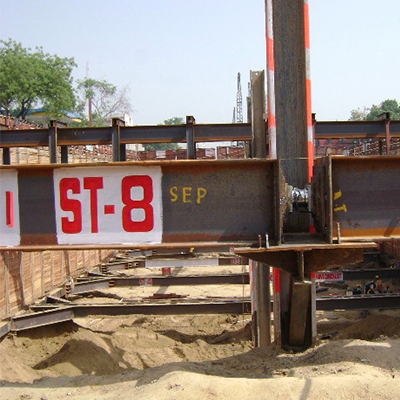
Figure 1: Compression load cell in between the strut at an under-construction metro station
The I-beam struts are usually installed in the framework of underground metro stations. The strain gauge solid load cells are widely used to measure the amount of load being transferred to the struts. The load cells are installed in between the struts.
Tie-backs, rock bolts, ground anchors
The anchor-back load cells are designed to test and measure the loads in tie-backs, rock bolts, and ground anchors. The load test is carried out by applying a load to the tie-back anchor with an in-line hydraulic jack.
The load cell is placed between the retaining wall and the hydraulic jack. Once the hydraulic jack opens up, the load transferred to the tie-back is measured by the load cell.
Retaining Wall
There are various types of retaining walls viz. sheet pile, anchored retaining walls, bored pile retaining walls, and cantilevered. The load cells are installed in these walls to monitor the changes behind them and study the effectiveness of different kinds of restraining systems at the same time.
The load cells measure and indicate the excessive load beforehand.
Diaphragm or Sheet Pile Wall

Figure 2: Anchor Load cell in the diaphragm wall at an under-construction metro station
To measure the stability of the diaphragm or sheet pile wall, load cells are installed in the tie-back anchor systems. However, the position of the load cell is in line with the struts installed.
Read more: Strain Gauge Type Load Cell- Introduction & How it Works?
Roof support in underground cavities / Slope stability in landslide zones
Underground cavities need to be monitored closely because they are under constant threat of roof collapse or sidewall falling.
Slope failures and landslides have been a major concern for geologists as they are the most common form of natural disaster. Hence, pre-stressed grouted anchors are used to provide active support to the walls and roofs.
Load cells measure the amount of load transferred and warn the respective authorities on time to avoid major mishaps.
Dams
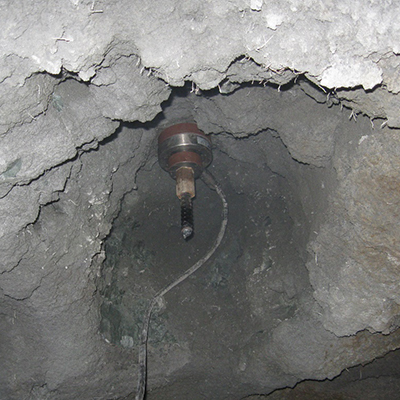
Figure 3: Anchor Load cell in the cavity in a dam.
The tie-back anchors are installed on the upstream side of a concrete dam to overturn the moments caused by very high flood conditions. Load cells are installed to monitor the anchor for the stability of the dam and provide early warnings.
Pile Load test

Figure 4: Compression load cell used in pile testing
Before constructing a structure, static load testing is carried out. The deep excavations and foundations are filled with piles to investigate their load-bearing capacity.
The load is applied by placing the hydraulic jack against the reaction piles and beam or directly by compressing.
What is the working principle of a load cell?
If you’ve ever wondered how load cell sensors work, here’s your answer!
The load cell principle involves the use of many specific geotechnical instruments. It can’t work without being paired up with sensors, one of them being Strain Gauges.
Strain Gauges are thin elastic materials made up of stainless steel and are fixed inside the load cells using proprietary adhesives. The strain gauge has a specific resistance that is directly proportional to its length and width.
When a force is applied to the load cell, it bends or stretches causing the strain gauge to move with it. And, when the length and cross-section of the strain gauge change, its electrical resistivity also gets altered, thereby changing the output voltage.
There is another concept involved with the working principle of load cells. Let’s have a look at it.
What is the Wheatstone Bridge?
Whenever the change in the resistance of the strain gauge takes place, it is displayed as an electrical output. But, have you ever wondered how the resistance change of a strain gauge is measured?
A load cell works only when the strain gauge has some change in its resistance and we use the Wheatstone Bridge to measure this change.
Load Cell Circuit
A load cell circuit is also known as a Wheatstone Bridge Circuit.

Let us assume that a load cell sensor has four internal strain gauges i.e. A, B, C, and D as shown in the image above.
The input voltage supplied by a signal conditioner or digital display is attached to the two opposite corners of the bridge i.e. C and D whereas, the output voltage is measured by joining the A and B resistors to the signal side of the digital display.
When no load is applied to the load cell (Load=0), the circuit is said to be balanced. As soon as the load is applied to it, the strain gauge resistors will witness a change in its resistance, thereby altering the voltage flowing through the circuit.
Hence, the voltage across A and B will change which will be displayed as the weight on the readout unit or the digital display.
The output of the Wheatstone bridge or a load cell is analog data which is converted to readable units using an interpreter.
Difference between Load Cell and Strain Gauge
This is a common question that we get from a lot of people. Since both these sensors are intricately involved with each other, people sometimes fail to find the difference between the two. The most obvious difference is that a strain gauge is a single resistive element while a load cell is an arrangement of four strain gauges in a Wheatstone bridge arrangement as stated above.
On the other hand, using a load cell needs the application of voltage to opposite nodes whereas to make use of a strain gauge, you need to arrange two to four strain gauges to experience opposite forces.
Types of Load Cells
When it comes to the many types of load cells, many offer different applications and principles. Let’s see the various types of load cells, their working, and specifications.
Model ELC-150S-H High Capacity Compression Load Cell

One of the first types of load cells is the Encardio Rite Model ELC-150S-H high-capacity compression load cell which is extensively used for compressive load measurement during testing of piles. For testing piles at loads greater than 12,500 kN, more than one load cell can be used.
The Encardio Rite model ELC-150S-H is a resistive strain gauge type precision engineered, high capacity load cell sensor designed to measure large compressive load or axial forces. It is specially designed for civil engineering applications. It is available in capacities ranging from 5000 kN to 12500 kN.
Working of Load Cell – Model ELC-150S-H
If you’re wondering how a strain gauge load cell works, let’s take a look at it.
The compression strain gauge load cell comprises a columnar element of high-strength martensitic stainless steel. The sensor utilizes sixteen 350 Ohm resistance strain gauges, wired to form a 1400 Ohm bridge.
To minimize the effect of uneven and eccentric loading, the strain gauges are equally spaced along the circumference.
The load applied to the cell can be measured by using any standard digital read-out unit suitable for resistance strain gauge applications. The load cell has great resistance to extraneous forces and is protected against dust, moisture, and adverse environmental conditions.
The sectional area of the element is varied in the different capacity load cells to give approximately the same millivolt output for a variation of zero to full load.

Specifications of Model ELC-150S-H
| Range (kN) | 5000, 6000, 7500,10000 & 12500 |
| Rated output | 1.5 mV/V ± 10 % |
| Over range capacity | 120 % with a maximum of up to 14000 kN |
| Temperature limit | -20o to 80o C |
| Cable | Four-core shielded 5 m long; specify |
| Calibration accuracy | ± 0.25 % fs |
| Non-linearity | ± 1 % fs |
Model ELC-210S Resistive Strain Gauge Type Compression Load Cell
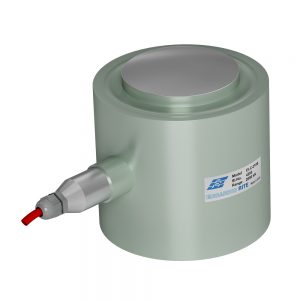
The Encardio Rite Model ELC-210S resistive strain gauge type compression load cell is a heavy-duty precision load cell. It is specially designed to meet the increasing demand for load measurement with a high degree of accuracy and reliability.
The load cell sensor is ideally suited for the measurement of compressive load or forces in strut applications. It is available in capacities ranging from 1000 kN to 3500 kN.
Construction of Model ELC-210S
The internal construction of the load cell is columnar. The element of the load cell is made of martensitic stainless steel. The element is hardened to give better linearity and hysteresis. The strain gauges used are of foil type and are bonded to the elements using special epoxy cement which is very reliable.
Read more: Understanding Sieve Trays in Soil Analysis
Operating Principle of Model ELC-210S
The working of the load cells involves the use of a strain sensor circuit.
The electron beam welded sensor utilizes precision bonded foil strain gages connected in a simple Wheatstone bridge circuit. The output is derived from imbalances in the bridge circuit as the load is sensed by the sensor.
Typically the bridge circuit is excited by 10 V DC to give a full-scale output of around 1.5 mV/V. The load applied to the cell can be measured by using any standard digital read-out unit suitable for resistance strain gauge applications.

Load Cell Specifications of Model ELC-210S
| Range (kN) | 1000, 1500, 2000, 3000, 3500 |
| Rated output | 1.5 mV/V ± 10 % |
| Enclosure | IP 68, electron beam welded under a vacuum of 1/1000 Torr |
| Temperature limit | -20o to 80o C |
| Cable | Four-core shielded 2 m long; specify |
| Over range capacity | 120% |
| Calibration accuracy | ± 0.25 % fs |
| Non-linearity | ± 1 % fs |
Model ELC-30S Resistive Strain Gauge Type Center Hole/Anchor Bolt Load Cell

This type of load cell is the Encardio Rite Model ELC-30S resistive strain gauge type center hole load cell which is extensively used to determine the load in rock bolts, tiebacks, foundation anchors, cables, or struts depending on the application. It is also used for compressive load measurement between structural members i.e. tunnel supports or at the junction between a beam and the top of a pile strut.
The Encardio Rite model ELC-30S is a precision-engineered resistive load cell with a central cylindrical hole. The cylindrical load cell sensor is specially designed for civil engineering applications and is available in capacities ranging from 200 kN to 2000 kN.
Operating Principle of Model ELC-30S
The center hole load cell comprises an element of high-strength martensitic stainless steel. It uses eight 350 Ohm resistance strain gauges, wired to form a 700 Ohm Bridge. To minimize the effect of uneven and eccentric loading, the eight strain gauges are mounted at 45° to each other in a groove at the base of a stainless steel columnar element.
The load applied to the cell can be measured by using any standard digital read-out unit suitable for resistance strain gauge applications. The strain gauges are mounted in a groove at the base of a stainless steel columnar element.
A stainless steel diaphragm is an electron beam welded to the element to cover the groove resulting in a vacuum of around 1/1000 Torr inside the sensor.
All this helps in the sensor becoming immune to atmospheric corrosion and the effect of ingress of water. The sectional area of the columnar element and the depth of the groove in it are varied in different capacity load cells to give approximately the same mV/V output for a variety of zero to full loads.

Specifications of Model ELC-30S
| Range (kN)/ID (mm) | 200/40, 500/52, 1000/78, 1000/105, 1500/85,1500/130, 2000/105, 2000/155, specify |
| Over range capacity | 120% |
| Calibration accuracy | ± 0.25 % fs |
| Non-linearity | ± 1 % fs |
| Temperature limit | -20o to 80o C |
| Cable connection | Six-pin glass to-metal seal |
Model ELC-30S-H Resistive Strain Gauge Type Center Hole/Anchor Bolt Load Cell

A load cell is used to determine the load in rock bolts, tiebacks, foundation anchors, cables, or struts depending on the application. Encardio Rite Model ELC-30SH is also used for compressive load measurement between structural members i.e. tunnel supports or at the junction between a beam and the top of a pile strut.
The Encardio Rite model ELC-30S-H is a precision-engineered high-capacity load cell with a central cylindrical hole. It is specially designed for civil engineering applications. It is available in capacities ranging from 3500 kN to 10000 kN.
Read more: Infrastructure Resilience: Geotechnical Health via Temperature Sensing
Operating Principle of Model ELC-30S-H
The center hole load cell comprises a cylinder of high-strength martensitic stainless steel. It generally uses eight 350 Ohm resistance strain gages, wired to form a 700 Ohm Bridge for capacity 3500 kN and 5000 kN. For capacities above 5000 kN, sixteen 350 Ohm resistance strain gages are used to form 1400 Ohm Bridge.
To minimize the effect of uneven and eccentric loading, the strain gauges are equally spaced along the circumference. The load applied to the cell can be measured by using any standard digital read-out unit suitable for resistance strain gauge applications.
The sectional area of the element is varied in the different capacity load cells to give approximately the same millivolt output for a variation of zero to full load.


Load Cell Specifications of Model ELC-30S-H
| Range (kN)/ID (mm) | 3500/185, 5000/202, 7500 /227, 10000/210, specify |
| Over range capacity | 120% |
| Non-linearity | ± 1 % fs(± 0.5 % fs is available) |
| Output | 1.5 mV/V ± 20 % |
| Excitation | 10 V DC (max. 20 V DC) |
| Temperature limit | -20o to 80o C |
| Cable connection | Four cores shielded 5m long, specify |
Model ELC-31V Vibrating Wire Hydraulic Center Hole-Anchor Bolt Load Cell
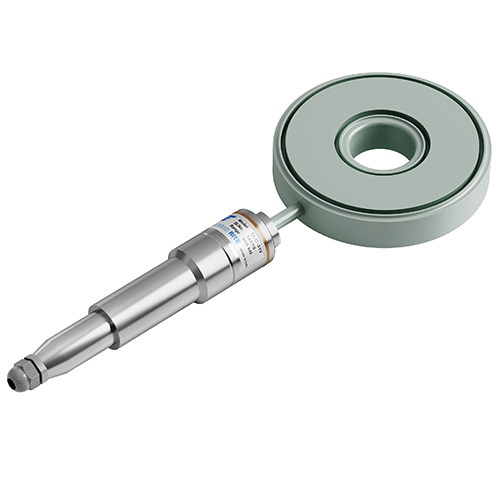
The Encardio Rite Model ELC-31V is a precision-engineered vibrating wire hydraulic center hole load cell, specially designed for civil engineering applications. It is fluid-filled and is constructed from stainless steel. It is available in capacities ranging from 250 kN to 2000 kN.
Operating Principle of Model ELC-31V

The model ELC-31V vibrating wire load cell is made of a sensitive pressure pad which is formed by joining together two very stiff steel discs at their periphery. The space inside the cell is filled with de-aired fluid. When the load is applied to the cell, the pressure on the fluid changes.
This change in fluid pressure is used to record the variation in the load being applied to the cell. The load is distributed equally over the loading area of the cell by a thick, distribution plate. Load distribution plates can be used both above & below the load cell sensor to ensure an even distribution of load onto the cell.
Bottom load distribution plates are not required if an adequate bearing plate has been incorporated into the proposed installation arrangement.
The pressure in the load cell is measured by a vibrating wire pressure transducer. The vibrating wire pressure transducer is of stainless steel construction and incorporates the latest vibrating wire technology to provide electrical read-out. A glass-to-metal seal is provided for easy cable connection.
The data from the vibrating wire pressure transducer can be read by the Model EDI-51V read-out data logger. The data can also be remotely read by the Model EDAS-10 automatic data acquisition system.
Read more: Temperature Sensors: Definition, Types, Uses, Benefits, Working
Specifications of Model ELC-31V
| Range (kN)/ID (mm) | 250/35, 500/52, 750/78, 1000/105, 2000/130, 2500/0 |
| Overload | 110 % fs |
| Calibration accuracy | ± 1 % fs |
| Non-linearity | ± 2 % fs from 10% to full range |
| Temperature limit | -10o to 50o C |
| Temperature effect | ± 0.06% fs/o C |
| Thermistor | YSI 44005 or equivalent |
Model ELC-32V Vibrating Wire Center Hole-Anchor Bolt Load Cell

The Encardio Rite Model ELC-32V is a precision-engineered load cell sensor with a central cylindrical hole. It is specially designed for civil engineering applications.
It is available in capacities ranging from 250 kN to 3500 kN. Higher capacity load cells and those having an internal diameter different from the standard specified range are available on request.
Operating Principle of Model ELC-32V
The center hole load cell sensor comprises a cylinder of high-strength martensitic stainless steel. It generally uses three vibrating wire strain gages mounted at 120° to each other to minimize the effect of uneven and eccentric loading.
The load applied to the cell is measured individually by the vibrating wire strain gauges using an Encardio Rite model EDI-51V digital read-out unit for vibrating wire load cells. The average of the three readings is taken.
Alternatively, the load cell can be connected to the Encardio Rite model EDAS-10 data acquisition system for continuous monitoring. If specifically required, the load cell can be provided with four or six vibrating wire strain gages.
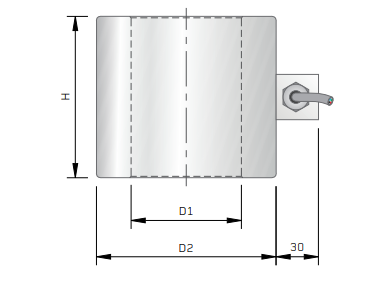
Load cell Specifications of Model ELC-32V
| Range (kN)/ID (mm) | 250/27, 500/52, 1000/78, 1500/102, 2000/127, 2000/152, specify (solid load cell available on request) |
| Overload | 150 % |
| Calibration accuracy | ± 0.25 % fs |
| Non-linearity | ± 1 % fs |
| Temperature limit | -20o to 80o C |
| Thermistor | YSI 44005 or equivalent |
| Cable | Six core shielded 5 m long; specify |
Pneumatic Load Cell
Pneumatic Load cells are designed such that the balancing pressure is automatically adjusted by them. The pneumatic load cell working is based on the following concept.
When air pressure is applied to one end of the diaphragm, it releases through the other end/nozzle, at the bottom of it. A pressure gauge attached to the load cell sensor measures the pressure inside the cell. The deflection of the diaphragm changes the airflow through the nozzle as well as the pressure inside the chamber or diaphragm.
Piezoelectric Load Cell
Piezoelectric load cells work on the same principle as that of the strain gauge load cells but, the voltage output is generated by piezoelectric material which is proportional to the deformation of the load cell.
The Piezoelectric load cells find their application in the areas of dynamic loading where strain gauge load cells often fail with high dynamic loading cycles. The piezoelectric effect is dynamic, which means the electrical output of a gauge is a non-static impulse function. The voltage output is useful only when the applied force or strain is changing and does not measure static values.
Let’s have a look at the piezoelectric Load Cell advantages and disadvantages. Some of the pros are that they are compact and hence, extremely easy to handle. They also have a good frequency response and rugged construction for harsh applications. On the downside, it has high-temperature sensitivity and is not suitable for static conditions.
Advantages of a Load Cell
- Load Cells have rugged & robust construction along with outstanding reliability and long-term stability
- They are specially designed to suit the harsh & severe industrial environment.
- Load Cells are temperature compensated.
- They have a stable system with no moving parts and linkages.
- A few of them have multiple strain gages incorporated to reduce the positioning effect.
- Any standard strain gauge bridge measuring read-out device can be used with the load cells.
- The load cells have negligible side and eccentric load effects.
Read more: IPIS: The Game-Changing Solution for Efficient Monitoring
Applications of Load Cells
The applications of load cells include:
- To determine the load in rock bolts, tiebacks, foundation anchors, cables, or struts.
- Proof testing and long-term performance monitoring of different kinds of anchor systems.
- Compressive load measurement between structural members i.e. tunnel supports or at the junction between a beam and the top of a pile strut.
- Used extensively for correlating data obtained from borehole extensometers.
- To determine the load in experimental research, pile testing, and measurement of the thrust of rocks.
- Compressive load measurement between structural members.
- Measurement of compressive load and axial forces in struts.
- Load testing in piles.
- Determination of roof convergence in underground mines.
FAQs
Q1. How accurate are load cells?
Ans: The % RO (Rate Output) of all the load cells that Encardio Rite has is mentioned in its specifications. The accuracy of a load cell sensor is determined through its %RO. If a 10,000 kg load cell has an error of ± 0.5%RO, it means the best resolution of the load cell would be ±50Kg
Q2. What is load cell sensitivity?
Ans: Load Cell Sensitivity is a very important factor for the instrument. A sensitivity of 3mV/V means that the load cell produces an output signal of 3mV at nominal force when the input voltage is 1V.
Q3. What is load cell calibration?
Ans: Over time, load cells tend to age and misalign. Hence, there’s a need to calibrate them regularly. The comparison of actual load cell outputs against the test loads is known as calibration.
Q4. What is the difference between a load cell and a strain gauge?
Ans: A strain gauge is a single transducer used to convert the mechanical deformation into readable electrical output. Whereas, a load cell comprises an array of strain gauges that convert the mechanical load into readable units.
Q5. What is a primary axis?
Ans: The axis along which the load cell is designed to be loaded is known as the primary axis.
Q6. What is Axial Load?
Ans: It is the load applied along the primary axis.
Q7. What is non-linearity?
Ans: The difference between the output at a specific load and the corresponding point on the straight line drawn between minimum load and maximum load is termed Non-Linearity. It is usually expressed in units of %FS.
Q8. What is non-repeatability?
Ans: The maximum difference between output readings for repeated loadings while keeping the loading and environmental conditions identical is known as Non-Repeatability. This was all about the Load Cells and their different types. If you have any queries, feel free to comment below.